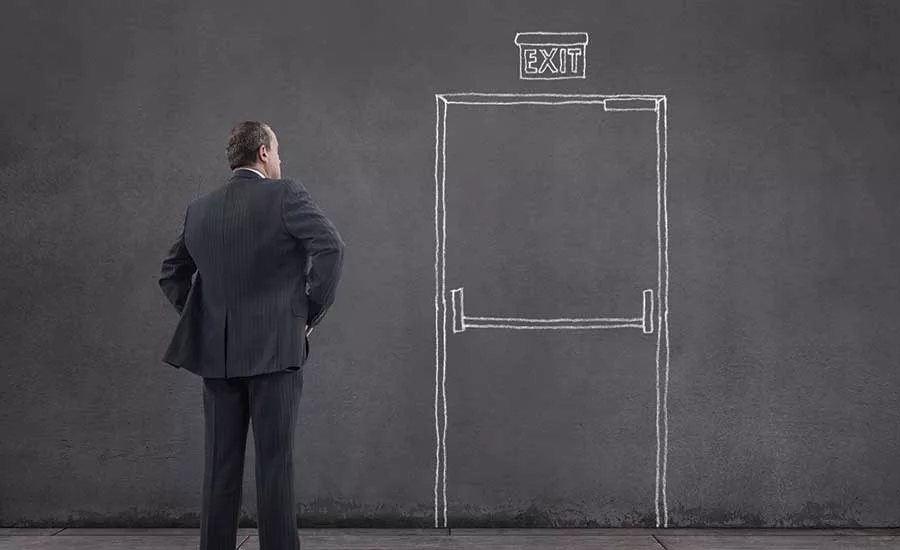7 Key Risks in Your Roofing Business Exit

Most company owners have never exited a business and are unaware that the odds are against them.
Roofing Contractors intuitively understand and manage their everyday risks in a measurable manner, but most company owners have never exited a business and are unaware that the odds are against them.
Fewer than 20 percent of the companies brought to market actually sell, and fewer than 30 percent of family businesses will transfer to the second generation.
Would it make ense to invest some time in your exit to reduce these odds since 70 percent of your wealth is trapped inside your illiquid business?
Beacon Exit Planning has identified seven recurring pitfalls that can derail owners from successfully navigating their inevitable exit. Understanding these common problems, risks and concerns of exiting a business can help business owners prepare for and manage their future exits.
1) Lack of Planning
“At any given time, 40 percent of U.S. businesses are facing the transfer of ownership issue. The primary cause for failure … is the lack of planning,” according to the U.S. Small Business Administration.
Most owners are just too busy running their business to take time to plan for their exit. They probably have completed a will, some estate planning and a buy-sell agreement, but not a clear coordinated exit plan. Besides, it’s an intimidating process coordinating and understanding all the different information and contradictions coming from the different advisers.
Procrastinating owners often wait too long, only to be forced to liquidate their business for pennies on the dollar, leaving an irresponsible legacy behind.
2) Outliving Earnings
The number one fear for affluent Americans over 55 is running out of money in retirement, according to the results of Bank of America’s latest Merrill Edge Report. Most business owners are considered affluent.
Their business pays them generously, supports their lifestyle, travel, autos and entertainment. However, industry studies show that their largest segment of wealth (in our experience, more than 70 percent) is trapped in their illiquid business.
The owner’s challenge is how to live independently from the business, cash out without being clobbered by taxes, retire and not outlive their money.
Developing a financial plan as part of the overall exit plan can help an owner ensure they have sufficient income replacement after departing the business.
3) Risk Exposure in Buy-Sell Agreements
Early in our process, there’s a review of personal and business documents. The buy/sell agreement is usually one of the first to be examined. In many cases, we’ve uncovered provisions that could be devastating to the business owner, the company and the family.
The risks often expose millions of dollars in unnecessary tax liabilities or structures that don’t support the owners’ intentions. This exposure is unrecognized by existing advisers and must be confronted immediately before we even begin to draft the exit plan.
Common risks include:
An underfunded or unfunded buyout of an owner’s business interest. Typically supported by life insurance or at the very least clear, concise terms for a buy out over time.
Improper valuation formulas and definitions that can create ambiguities and confusion. Understanding the standard of value is critical.
Insurance policies that are improperly coordinated, creating potentially significant tax consequences. Who will be the beneficiary? The company or the remaining owners? Why?
The Buy/Sell Agreement is a living, breathing document and should be reviewed periodically to determine if it still supports the changing business and owner environment.
4) Odds of an External Sale
As mentioned previously, fewer than 20 percent of the companies brought to market actually sell, according to the U.S. Chamber of Commerce. This figure is closer to 10 percent with construction companies, according to FMI Corp. To increase the odds of a successful external sale (a sale to a consolidator or competitor), an owner should:
Not wait until a buyer approaches for a one-on-one negotiation. Once the company is sale-ready, the owner should plan to market the business to several competitive bidders, which may increase the odds for achieving the highest price and financial independence from the business.
Find an experienced and proven mergers and acquisition professional, and get the company sale-ready to receive the highest possible price.
Solidify Management Retention is going to be a critical aspect for getting a higher price. In many cases a buyer will want a seasoned management team that understands the relationships beyond the business owner and can be instrumental in continued profitability and cash flow.
5) Odds of an Internal Sale
Fewer than 30 percent of family businesses will transfer to the second generation, of that 30 percent only 10 percent will transfer to the third generation, according to the Family Firm Institute. In simple terms, there’s less than a three percent chance that your company will see a third generation at the reins.
Most of private business sales in the lower to mid-level markets ($5 million to $60 million) will be an internal sale, transferring via an Employee Stock Ownership Plan, a management buyout or through gifting.
Succession planning is key as you must depend on the management to produce the profits that will buy your stock. You need to move your existing managers into a professional level, into leadership and replace yourself. I recommend you have a formal process in place beginning fifteen years before your retirement.
The good news ? If the internal sale is structured properly, the after-tax results can be more favorable than an external sale.
6) Inefficient Taxation
Each exit path has a different tax implication that can range from zero percent to more than 60 percent. Many factors come into play, such as entity structure, tax history and characteristics, and the deal structure itself.
An external sale, if not properly structured, could come with a tax yield of 60 percent or greater. The external sale might generate the highest sales price, but it could leave an owner with the fewest dollars. The bottom line for owners — it’s not how much you get, but how much you keep.
An internal sale may have a smaller tax consequence for the owner. However, usually these deals are often improperly structured in a way that creates more of a tax burden for the seller and the buyer.
Owners should investigate strategies that can be implemented to make the transaction much more tax efficient to reduce the financial risk to the company, the buyer and the sellers. It’s critical since the company’s cash flow (profit) pays for everything in the internal exit.
7) Predators and Creditors
Businesses are natural targets for lawsuits because of their perceived wealth and deep pockets. An owner can be blindsided and targeted by creditors or sued for events in which he or she did not ever participate. Imagine working for 20, 30 or 40 years and losing everything in a lawsuit.
A successful exit plan should protect what an owner has earned from litigation, so it’s there when he or she eventually exits.
Exit planning should utilize strategies such as asset insulation to structure a business, making it less attractive to litigation.
Asset insulation positions assets and finances so that it’s difficult for a creditor to reach them in a judicial claim. It also:
Creates a barrier around the valuable assets making them difficult to access by a claimant or creditor;
Promotes settlement, due to the barrier and difficulty accessing the assets;
Integrates with estate planning and tax minimization objectives without gifting assets or losing control of those assets.
The intent of this article is to educate you on the risks involved in the exit process and for you not to approach the largest financial event of your life in a casual manner. Remember, the largest cause of failure in the exit is lack of planning.
Looking for a reprint of this article?
From high-res PDFs to custom plaques, order your copy today!







